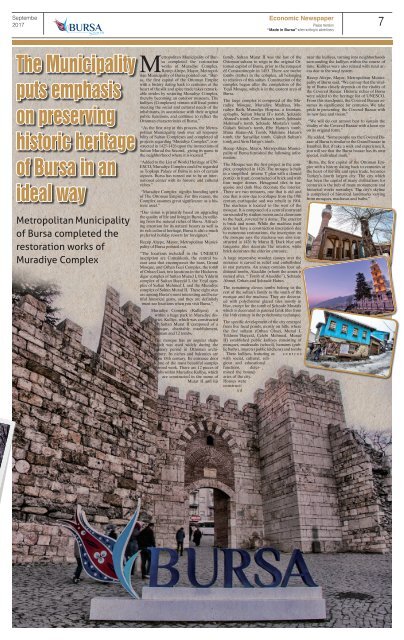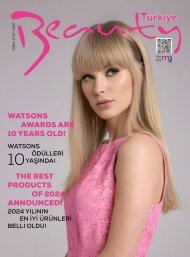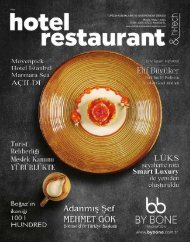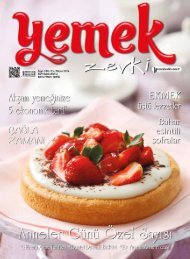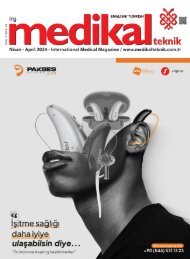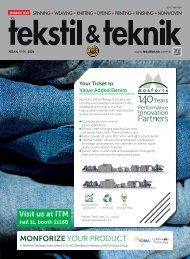Made In Bursa September 2017
Create successful ePaper yourself
Turn your PDF publications into a flip-book with our unique Google optimized e-Paper software.
Septembe<br />
<strong>2017</strong><br />
Economic Newspaper<br />
Please mention<br />
“<strong>Made</strong> in <strong>Bursa</strong>” when writing to advertisers<br />
7<br />
The Municipality<br />
puts emphasis<br />
on preserving<br />
historic heritage<br />
of <strong>Bursa</strong> in an<br />
ideal way<br />
Metropolitan Municipality<br />
of <strong>Bursa</strong> completed the<br />
restoration works of<br />
Muradiye Complex<br />
Metropolitan Municipality of <strong>Bursa</strong><br />
completed the restoration<br />
works of Muradiye Complex.<br />
Recep Altepe, Mayor, Metropolitan<br />
Municipality of <strong>Bursa</strong> pointed out, “<strong>Bursa</strong>,<br />
the first capital of the Ottoman Empire<br />
with a history dating back to centuries at the<br />
heart of the silk and spice trade takes remarkable<br />
strides by restoring Muradiye Complex,<br />
thereby becoming an outdoor museum. The<br />
kulliyes (Complexes) remain still focal points<br />
meeting the social and cultural needs of the<br />
inhabitants, in accordance with their original<br />
public functions, and continue to reflect the<br />
Ottoman characteristics of <strong>Bursa</strong>.”<br />
“As the first step in this process, the Metropolitan<br />
Municipality took over all responsibility<br />
of Sultan Complexes and completed all<br />
projects regarding ‘Muradiye Complex”, constructed<br />
in 1425-1426 upon the instructions of<br />
Sultan Murad the Second, giving its name to<br />
the neighborhood where it is located.”<br />
“Added to the List of World Heritage of UN-<br />
ESCO, Muradiye Complex could be regarded<br />
as Topkapı Palace of <strong>Bursa</strong> in ters of certain<br />
aspects. <strong>Bursa</strong> has turned out to be an international<br />
center with its historic and cultural<br />
riches.”<br />
“Muradiye Complex signifys founding spirit<br />
of The Ottoman Empire. For this reason, the<br />
Complex assumes great significance as a historic<br />
asset.”<br />
“Our vision is primarily based on upgrading<br />
the quality of life and living in <strong>Bursa</strong>, by utilizing<br />
from the natural riches of <strong>Bursa</strong>. Attracting<br />
attention for its natural beauty as well as<br />
its rich cultural heritage, <strong>Bursa</strong> is also a much<br />
preferred holiday resorts for foreigners.”<br />
Recep Altepe, Mayor, Metropolitan Municipality<br />
of <strong>Bursa</strong> pointed out,<br />
“The locations included in the UNESCO<br />
inscription are Cumalıkızık, the central bazaar<br />
area that encompasses the hans, Grand<br />
Mosque, and Orhan Gazi Complex, the tomb<br />
of Orhan Gazi, two locations in the Hüdavendigar<br />
complex of Sultan Murad I, the Yıldırm<br />
complex of Sultan Bayezid I, the Yeşil complex<br />
of Sultan Mehmed I, and the Muradiye<br />
complex of Sultan Murad II. These eight sites<br />
are among <strong>Bursa</strong>’s most interesting and beautiful<br />
historical gems, and they are definitely<br />
must-see locations when you visit <strong>Bursa</strong>.”<br />
Muradiye Complex (Kulliyesi) is<br />
within a huge park in Muradiye district.<br />
Kulliye, which was constructed<br />
by Sultan Murat II composed of a<br />
mosque, charitable establishment,<br />
hamam and 12 tombs.<br />
The mosque has an angular shape<br />
which was used widely during the<br />
primary period in Ottoman architecture.<br />
Its niches and balconies are<br />
from 18th century. Its entrance door<br />
is one of the most beautiful samples<br />
of wood work. There are 12 pieces of<br />
tombs within Muradiye Kulliye, which<br />
are constructed in the name of<br />
Murat II and his<br />
family. Sultan Murat II was the last of the<br />
Ottoman sultans to reign in the original Ottoman<br />
capitol of <strong>Bursa</strong>, prior to the conquest<br />
of Constantinople in 1453. There are twelve<br />
tombs (türbe) in the complex, all belonging<br />
to relatives of this sultan. Construction of the<br />
complex began after the completion of the<br />
Yeşil Mosque, which is in the eastern area of<br />
<strong>Bursa</strong>.<br />
The large complex is composed of the Muradiye<br />
Mosque, Muradiye Madrasa, Muradiye<br />
Bath, Muradiye Hospice, a fountain,<br />
epitaphs, Sultan Murat II’s tomb, Şehzade<br />
Ahmed’s tomb, Cem Sultan’s tomb, Şehzade<br />
Mahmud’s tomb, Şehzade Mustafa’s tomb,<br />
Gülşah Sultan’s tomb, Ebe Hatun’s tomb,<br />
Hüna Hatun-Ak Tomb, Mukrime Hatun’s<br />
tomb, the Saraylilar tomb, Gülrah Sultan’s<br />
tomb and Sirin Hatun’s tomb.<br />
Recep Altepe, Mayor, Metropolitan Municipality<br />
of <strong>Bursa</strong> furnished the following information:<br />
The Mosque was the first project in the complex,<br />
completed in 1426. The mosque is built<br />
in a simplified inverse T plan with a domed<br />
portico in front, constructed of brick and with<br />
four major domes. Hexagonal tiles in turquoise<br />
and dark blue decorate the interior.<br />
There are two minarets, one that is old and<br />
one that is new due to collapse from the 19th<br />
century earthquake and was rebuilt in 1904.<br />
The madrasa is located to the west of the<br />
mosque. It is composed of a central courtyard<br />
surrounded by student rooms and a classroom<br />
to the back, covered by a dome. The exterior<br />
is brick and stone. While the madrasa itself<br />
does not have a construction inscription due<br />
to numerous restorations, the inscription on<br />
the mosque says the madrasa was also constructed<br />
in 1426 by Murat II. Dark blue and<br />
turquoise tiles decorate the interior, while<br />
brick decorates the exterior entrance.<br />
A large impressive wooden canopy over the<br />
entrance is carved in relief and embellished<br />
in star patterns. An annex contains four ad-<br />
ditional tombs, Alaaddin (whom the annex is<br />
named after, “ Tomb of Alaaddin”), Şehzade<br />
Ahmet, Orhan and Şehzade Hatun.<br />
The remaining eleven tombs belong to the<br />
rest of the sultan’s family to the south of the<br />
mosque and the madrasa. They are decorat-<br />
ed with polychrome glazed tiles mostly in<br />
blue, except for the tomb of Şehzade Mustafa<br />
which is decorated in painted Iznik tiles from<br />
the 16th century in the polychrome technique.<br />
The specific development of the city emerged<br />
from five focal points, mostly on hills, where<br />
the five sultans (Orhan Ghazi, Murad I,<br />
Yıldırım Bayezid, Çelebi Mehmed, Murad<br />
II) established public kulliyes consisting of<br />
mosques, madrasahs (school), hamams (public<br />
baths), imarets (public kitchens) and tombs<br />
. These kulliyes, featuring as centres<br />
with social, cultural, religious<br />
and educational<br />
deter-<br />
functions,<br />
mined the boundaries<br />
of the city.<br />
Houses were<br />
constructe<br />
d<br />
near the kulliyes, turning into neighborhoods<br />
surrounding the kulliyes within the course of<br />
time. Kulliyes were also related with rural areas<br />
due to the waqf system.<br />
Recep Altepe, Mayor, Metropolitan Municipality<br />
of <strong>Bursa</strong> said, “We can say that the vitality<br />
of <strong>Bursa</strong> closely depends on the vitality of<br />
the Covered Bazaar. Historic riches of <strong>Bursa</strong><br />
were added to the heritage list of UNESCO.<br />
From this standpoint, the Covered Bazaar assumes<br />
its significance for centuries. We take<br />
pride in presenting the Covered Bazaar with<br />
its new face and vision.”<br />
“We will do our utmost best to sustain the<br />
vitality of the Covered Bazaar with a keen eye<br />
on its original form.”<br />
He added, “Some people say the Covered Bazaar<br />
of <strong>Bursa</strong> is similar to the Grand bazaar in<br />
Istanbul. But, if take a walk and experience it,<br />
you will see that the <strong>Bursa</strong> bazaar has its own<br />
special, individual mark.”<br />
“<strong>Bursa</strong>, the first capital of the Ottoman Empire<br />
with a history dating back to centuries at<br />
the heart of the silk and spice trade, becomes<br />
Turkey’s fourth largest city. The city which<br />
has been the capital of many civilizations for<br />
centuries is the hub of many monuments and<br />
historical works nowadays. The city’s skyline<br />
is comprised of historical landmarks varying<br />
from mosques, madrasas and baths.”


